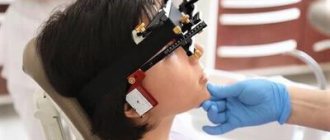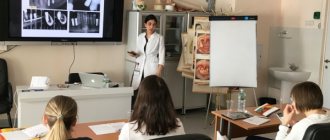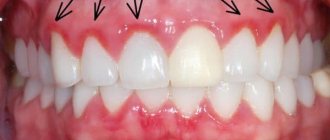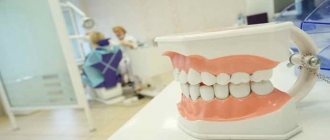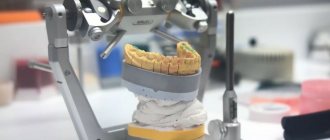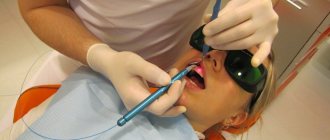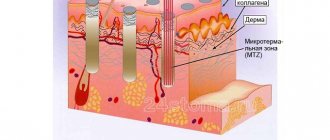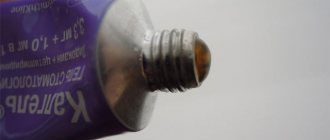9942
Orthodontics is the oldest branch of dentistry, but it began its active development not so long ago. The methods used in this area are becoming more and more effective, and specialists are in maximum demand. Now only 6% of dentists are orthodontists, and the success of treating abnormal dentition depends on them.
Who is an orthodontist?
An orthodontist is a dentist who corrects bite defects, straightens jaws and corrects dentition.
This type of dentistry studies the causes of abnormal development of the jaw apparatus and classifies pathologies. In turn, orthodontists, in practice, correct defects using special techniques, instruments and additional materials.
An equally important area in orthodontics is the prevention of curvature of the jaws and teeth and the prevention of relapses of diseases.
Why visit an orthodontist?
Many people believe that an orthodontist only works with children and adolescents. And if you have already grown up and reached maturity, then nothing can change your bite and teeth. This is a huge misconception, but remember: the sooner you start correcting, the faster and cheaper the treatment will be, and the risk of side effects will be reduced.
Preschoolers and schoolchildren must visit an orthodontist. At this age, teeth change and dentition begins to form. It is important to detect the problem in time and stop it in a timely manner.
Child at an appointment with an orthodontist
Don't put off visiting the dentist for too long. The doctor will be able to diagnose all problems, give professional recommendations and prescribe the right treatment. In childhood, the problem can only be solved with myotherapy.
A preschooler will not be given full treatment, since braces can only be installed on molars. Milk teeth have unstable roots that gradually dissolve. Young children may have plates installed to shape their jaw.
Teenagers can already wear braces and receive full treatment that will correct all problems and make their teeth straight.
Before starting treatment, you need to take an x-ray to give an accurate prognosis of its results. Sometimes problems are discovered that should be taken into account at the initial stage of treatment by adjusting the treatment plan.
Directions of orthodontic treatment
In the minds of patients, an orthodontist is a dentist who treats crooked teeth. Which is true, but that's only part of the orthodontist's job.
The main direction of orthodontics is the correction of congenital or acquired malocclusions and the elimination of the causes that led to the occurrence of the disease.
Pathologies included in the scope of activity of orthodontists:
- The main direction of orthodontics is the correction of congenital or acquired malocclusions
dysfunction of the speech apparatus and disturbances in the functioning of the respiratory system;
- changing the shape of the face;
- deterioration of chewing function;
- manifestations of bite pathologies;
- abnormal changes in the arrangement of individual teeth and dentition.
Depending on the time of development of clinical manifestations of the disease, pathologies are classified as:
- congenital - curvature of milk and permanent teeth, complete or partial edentia.
- appeared some time after the birth of the child;
- hereditary.
The responsibilities of an odontist include:
- preparation and implementation of orthodontic intervention;
- replacement of lost teeth;
- correction of the direction of tooth growth, jaw shape, facial part;
- preparation for orthopedic procedures.
The condition of the dentofacial apparatus directly affects the functioning of the gastrointestinal tract, and also has psychological significance, as it is associated with the aesthetic perception of the individual by society.
Psychological discomfort, in turn, negatively affects the functioning of the nervous system and internal organs, which is why it is so important, in case of problems with the jaw apparatus, to consult an orthodontist in a timely manner.
What does a specialist do: diagnosis and treatment
An orthodontist is a specialist who corrects bites. A specialist with a narrow profile does not perform dental treatment, filling diseased canals or other dental procedures. Correction of the bite occurs in several successive stages: the final result depends on the competent approach of the doctor.
Content:
- What does a specialist do: diagnosis and treatment
- What are the names of the diseases and injuries that the doctor treats?
- What symptoms should you consult a doctor for?
- Stages of treatment
- Treatment methods
At the initial appointment with a specialist, a diagnosis is carried out: an examination by a doctor, drawing up a general picture of the disease (if a person comes with a specific problem, a consequence of dental diseases) and drawing up a treatment plan. The work of an orthodontist, unlike a dentist, takes several weeks, and sometimes the patient undergoes a year of treatment to completely correct the bite.
Both adults and children undergo primary diagnostics. In adolescence, changes in the skeletal system occur much easier, so treatment by an orthodontist takes less time. For adult patients, the doctor develops an individual treatment program. To correct the bite, special orthodontic structures of varying complexity are used.
It is advisable to undergo treatment by an orthodontist for patients who have undergone surgery. Correcting the bite and shape of the dentition after surgery is a complex process that requires a well-qualified doctor.
What organs does it treat?
What does an orthodontist do? A dentist who corrects bites carries out a number of therapeutic measures. The primary task of a specialist is to correct dental anomalies in adult and small patients. The orthodontist's job is to correct congenital, hereditary disorders or injuries that the patient has suffered from since childhood. Acquired adult defects are corrected gradually, if possible, without surgical intervention. The main problems with which people turn to an orthodontist are crooked teeth: they spoil the appearance and create complexes.
The doctor deals with the correction of bites of any form of complexity: slight curvature of the dentition and severe jaw abnormalities. Crowding of teeth or expansion of the dentition is the main profile of the work of an experienced orthodontist. Such anomalies form in childhood, when the child’s primary teeth erupt incorrectly. Uncut fangs or incisors can create a problem for the patient’s entire jaw, so a specialist takes measures to align the entire dentition, and not just the visible parts of the teeth.
Patients with breathing problems also seek help from an orthodontist. A person who has an irregular jaw shape may suffer from shortness of breath and attacks of suffocation. Chewing dysfunction is the first indication for contacting a specialist. Speech problems arise due to malocclusion even in adults, so the orthodontist prescribes comprehensive treatment, including visits to a speech therapist or other specialists.
In most cases, the reason for contacting an orthodontist is the shape of the jaw or the curvature of individual teeth. Recent studies have shown that the jaw of modern man has become significantly narrower than that of his ancestors. The result is crowded teeth, incorrectly cut incisors and wisdom teeth: frequent defects require correction, not only from the point of view of aesthetics, but also the health of an adult or small patient.
What diseases does it diagnose?
During the initial consultation, the orthodontist determines the entire scope of work. There are only three types of diseases that require special treatment. To make treatment and diagnosis easier, experts highlight the nature of the problem:
- congenital anomaly;
- hereditary problems;
- acquired defect.
The speed and complexity of treatment depends on the classification of the problem. Malocclusion can develop gradually, especially in young children. An initial examination of a young patient by an orthodontist will help determine the development of the problem and its further elimination.
Pediatric orthodontist
The formation of a correct bite occurs at an early age, and it is the responsibility of parents to monitor the growth of teeth and the formation of the child’s dentition.
At the same time, parents make a serious mistake by deciding that baby teeth are not important for the normal development of the child.
Attention! If you discover bite defects, immediately contact a pediatric orthodontist.
The standard treatment regimen looks like this:
- In dental clinics, braces are installed for children after the formation of the molar bite, at the age of 11-12 years.
diagnostics of oral cavity condition;
- drawing up a treatment plan for pathology;
Children's malocclusions are corrected:
- Prescribing myotherapeutic exercises for the lips and tongue, developing individual muscle groups - receptors for facial expressions and chewing.
- Installation of bite-correcting orthodontic plates.
- Wearing mouthguards - transparent overlays for straightening individual teeth.
For complex, advanced curvatures, orthodontists recommend the installation of braces - non-removable corrective plates. In dental clinics, braces are installed for children after the formation of the molar bite, at 11-12 years of age.
Important! A timely visit to a pediatric orthodontist will stop the development of bite pathology that has arisen due to abnormal development of the dental system.
Arsenal of possible treatment methods
Orthodontics involves the use of three main methods for treating jaw anomalies:
- Orthodontic plates
myotherapy;
- hardware treatment;
- surgical intervention.
The first method is suitable only for small children during the formation of the jawbone. These are a kind of preventive measures that, through a set of exercises, help the dentition to stand straight. Sometimes myotherapy is prescribed in combination with other types of treatment.
Hardware treatment involves the use of special equipment that has the necessary effect on the jaw. One has to resort to a scalpel in very advanced cases, when there is a risk of losing healthy teeth.
Reasons for contacting
Basically, orthodontists are pediatric doctors:
- It is recommended to bring a child to an orthodontist at the age of 2-3 years, with the appearance of the first teeth
It is recommended to bring a child to an orthodontist at the age of 2-3 years, with the appearance of the first teeth;
- the second, mandatory, appointment occurs at the age of five, when baby teeth are replaced by permanent ones;
Special reasons to visit a doctor:
- bad habits of the child;
- steady mouth breathing;
- congenital pathologies;
- irregular shape and direction of growing teeth.
If measures are not taken in a timely manner, the anomaly will develop into a complex form.
In turn, visiting a dentist will allow you to use effective preventive methods and save your child, in the future, from wearing braces for many years.
What symptoms should you consult a doctor for?
A specialized dentist does not treat caries, periodontitis or stomatitis. An orthodontist deals only with dental problems that cause specific symptoms. In young patients, chewing function is impaired; due to crowding of baby teeth, the incisors may fall out and crumble. Often, incorrect alignment of teeth leads to childhood caries and stomatitis, causing bleeding gums and severe pain.
For adult patients, crowded teeth or stretched dentition entails problems of a completely different nature: improper bite leads to severe pain in the joints. Due to overcrowding, it is difficult for a person to maintain oral hygiene, which results in varying degrees of caries. Improperly distributed load on teeth leads to cracks and chips of teeth. The main symptom with which an adult or a concerned parent turns to a specialist is the unsightly shape of the teeth and the curvature of the front incisors. Aesthetics plays an important role in orthodontics.
Reception
Those who have never visited an orthodontist will be interested to know how bite treatment occurs:
- The minimum duration of the retention period is equal to the treatment period, but can be longer and even permanent
Initial examination. The procedure includes interviewing the patient to make a preliminary diagnosis and familiarization with the treatment plan.
- Diagnostics. This includes: preparing casts of the jaws, casting plaster models to accurately measure deviations and displacements of the dentition, as well as x-rays (OPTG and TRG), photographs of the temporomandibular components, face and oral cavity.
The diagnosis ends with the patient being asked to choose the appropriate treatment from the proposed methods.
The treatment procedure consists of:
- From the installation of a teeth-correcting system, and consultation on the rules for using braces, dietary restrictions and special oral hygiene.
- From scheduled visits to the orthodontist, to determine intermediate results, and adjust braces.
The final period of correction of the dentofacial apparatus is retention. This:
- removal of correction plates.
- support for the resulting correction with retainers (thin wire attached to the teeth from the outside and inside)
The minimum duration of the retention period is equal to the treatment period, but can be longer and even permanent. Visit the orthodontist every six months during the retention period.
Methods: what does a pediatrician and a doctor do for adults and how does he treat?
Orthodontic problems are eliminated in two ways:
- Surgical . Intended for extreme cases when other therapy obviously will not bring results.
- Conservative . This is what orthodontists prefer, despite the fact that this method takes much more time. Includes two techniques: myotherapy and hardware treatment.
Myotherapy
This technique is a specially designed gymnastics that stimulates the work of the jaw muscles. Most often, myotherapy is used to correct childhood abnormalities if the age of the small patient does not allow the installation of corrective structures.
Adults can use this exercise as a preventive measure.
Myotherapy is a mandatory procedure for adults after removing braces and corrective plates to consolidate the effect obtained.
What is included in the method:
- Various exercises that affect the functioning of the tongue.
- Head tilts during chewing and swallowing.
- Yawning, moving the jaw from side to side or in a circle, as well as gargling.
- Massage the gums and soft palate with a brush.
Hardware
The main method in orthodontics is hardware treatment through the installation of corrective structures. It is performed at any age (recommended after replacing baby teeth), but it is worth considering that the therapy will take longer if the patient is over twenty years old.
Correction devices evenly distribute the load on the jaw, thereby aligning the dentition.
Such systems are divided into several types:
- Fixed structures.
- Braces. The braces are attached to the surface of the tooth with special glue, after which a metal arch is inserted into the grooves, fixed at the edges with a ligature. On the hooks of braces there are elastics - soft elastic bands that protect the oral cavity.
The arch regulates the pressure on the teeth, moving them until they are completely closed. The structure is tightened once a month, and the treatment itself lasts from six months to several years.The duration depends on the initial pathology and the age of the patient. Braces can be metal or ceramic. The latter are hardly noticeable on the teeth, some are almost transparent. Multi-colored braces are used for children.
- Permanent space fixers.
They are used if early loss of baby teeth occurs in order to preserve the freed-up space for the growth of a permanent crown. It is a wire arch fixed between the teeth adjacent to the free space.
- Braces. The braces are attached to the surface of the tooth with special glue, after which a metal arch is inserted into the grooves, fixed at the edges with a ligature. On the hooks of braces there are elastics - soft elastic bands that protect the oral cavity.
- Removable structures.
- Jaw plate. The principle of influence is the same as that of braces. It is secured to the teeth using an arch, which is periodically tightened to change the pressure on the dentition. Removable for eating or brushing teeth.
- Removable space clamps. They are made from acrylic that covers the arch of teeth and can be fitted with wire or plastic inserts to hold the space between crowns.
Important! Before installing corrective structures, a mandatory examination is carried out by a dentist and diseased teeth are cleaned and treated. In the future, the systems installed by the orthodontist may prevent you from solving the problem quickly.
Surgical
It should be said right away that such treatment is carried out by a dental surgeon. It is used in cases of severe pathology. Surgical treatment includes several methods:
- removal of teeth that interfere with the development of others;
- partial removal of bone tissue;
- compactosteotomy: cutting the bone in the problem area.
Surgical treatment is usually followed by conservative methods.
Stages
The procedure for treating orthodontic pathologies is a long and labor-intensive process. The main stages are:
- Diagnosis of teeth and oral cavity and treatment of identified problems (gum disease, caries, etc.)
- Professional teeth cleaning.
- Selection and installation of a corrective system. At this stage, if necessary, surgical intervention is performed.
- Regular visits to a specialist to monitor the results, correct them and regulate the pressure of the correction system.
- Completion of treatment.
- Retention stage. A thin wire or a special mouthguard is installed to record the results obtained. On average, this stage takes approximately half the time spent on the main treatment.
Features of work
The specialty of an orthodontist in dentistry is prestigious, highly paid and suitable for career growth. But to become even a novice specialist, you need to complete a medical university, an internship, and only then start working.
The specificity of orthodontics is the treatment of children, which requires skills and knowledge of child psychology and endurance.
Also specific to the profession are the physical characteristics of the doctor’s body: fine motor skills and 100% vision, otherwise, irreparable harm can be caused to the patient.
What should a doctor be able to do and know, what character qualities should he have?
We found out what orthodontics is, what an orthodontist does in dentistry, and now we’ll figure out what knowledge, skills and personal qualities a good specialist in this field should have. To begin with, it must be said that there is a job description that a doctor must follow. A practicing doctor must be able to accurately determine the pathology, its degree of complexity, select the optimal treatment method or a combination of several methods at once, adjust the plate or bracket system to the anatomical characteristics and install it correctly. In addition, this area of dentistry is developing very quickly, and a good specialist is obliged to constantly improve the level of his qualifications and introduce modern treatment methods into his practice.
A specialist must install the bracket system correctly
Another very important aspect is the psychological factor. Orthodontic treatment usually takes quite a long time - from six months to several years. Do not forget that most often this doctor has to deal with children, and in this case the ability to establish good communication with young patients is extremely necessary. To achieve the intended goals, an emotionally trusting contact must be established between the doctor and the patient. Thus, a good specialist also has certain personal qualities, such as communication skills and empathy.
The problem of choosing a specialist
When choosing a dentist for the next few years, collect as much information about him as possible.
Finding an intelligent orthodontist is not easy, since there are certain features in the work of a specialist when not only the result is important, but also its qualified consolidation.
Of course, the chosen specialist must understand diagnostics and have practical skills in treatment.
Signs of professional level:
- detailed consultation with a thorough study of bite pathology;
- providing patient choice in determining treatment options;
- the presence of positive results and noticeable improvement in the condition within the specified time frame;
- receiving detailed instructions at the end of the main treatment period.
The result of treatment is straight teeth and no bite defects.
When choosing a dentist for the next few years, collect the maximum amount of information about him, primarily regarding professional achievements and experience, ask to see photographs of the teeth of patients who were treated, and only then make a final decision.
Therapy methods
Let's briefly talk about the main treatment methods used in orthodontics.
Myotherapy
This technique is a specific gymnastics for the facial and masticatory muscles, which allows not only prevention, but also treatment of various anomalies of the dental system.
In the treatment of children, myotherapy is of primary importance , but in many cases it is also included in treatment complexes for adult patients.
Hardware treatment
This is the main method used in orthodontics. Various devices (both removable and non-removable) are used to exert a certain load and redistribute it throughout the entire jaw system.
It is their use that allows us to solve most problems in patients of different ages, including adults with an already formed bite.
Surgical
Sometimes surgery is also required to treat complex cases. It involves freeing up space in the jaw for the growth and normal development of teeth.
In this case, not only individual teeth are removed, but also areas of the jaw bone tissue that impede normal development.
How to become an orthodontist?
In general, the full training of an orthodontist lasts 8-9 years.
To become an orthodontist, you need:
- graduate from a higher medical institution with a degree in dentistry.
- Complete an internship or residency;
- undergo training at an educational center for young professionals.
- Regularly attend refresher courses.
In addition, attending lectures and seminars of colleagues and reading professional literature are encouraged. Such events allow you to stay on track and learn in a timely manner about new developments, new ideas and treatment methods in dentistry.
Is it difficult to become one?
The work of an orthodontist is very painstaking and hard work, which most often pays quite well. To obtain this qualification, you also need to work hard.
To do this, you need to go through several steps:
- Studying at a medical university at the Faculty of Dentistry.
- Completion of residency or internship in the specialty “orthodontics”.
- Receiving additional training in dental courses.
On average, the main period of study lasts about 8 years.
Treatment by an orthodontist
Typically, orthodontic therapy is a process consisting of several stages. The first stage is the time of intensive exposure, here the doctor applies all those treatment methods that are necessary to eliminate the problem of a particular patient. The second stage is the time of retention impact. Its main task is to consolidate the already achieved results of therapy.
The skill of a specialist lies not only in drawing up a competent treatment regimen for an existing dental anomaly, but also in the most gentle effect on the enamel. In order to minimize the possible risk of damage, doctors use modern orthodontic devices in their work.
There are many of them, depending on what therapeutic effect they are able to provide, they are distinguished:
- Combined devices, mechanical, functionally guiding, functionally operating. The classification criterion is the method of therapeutic intervention.
- Extraoral, double-jawed, single-jawed and combined devices. In this case, the area of impact becomes the classification criterion.
- Devices are fixed, removable or combined type. The classification criterion is the method of fixing the equipment.
- Devices are plate, frame, elastic, arc, mouthguard, block. The classification criterion is the appearance of the structure.
In order to achieve a positive result from the therapy, it is necessary to regularly wear the selected design. In this regard, problems most often arise in children, so strict monitoring by parents over compliance with all recommendations given by the orthodontist is necessary.
Of course, the question of an aesthetic nature arises, especially when it comes to wearing braces. They are used to eliminate anomalies in both adulthood and adolescence. To make the design as less noticeable as possible, you can choose sapphire braces. They are practically invisible on the teeth. These devices are suitable for people whose professional activities involve publicity.
